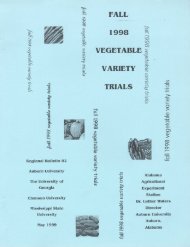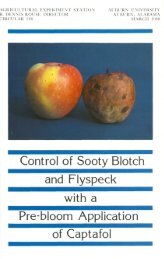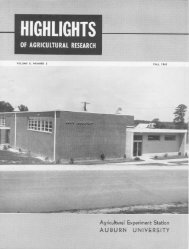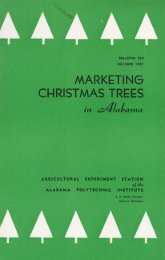1997 Ornamentals Research Report - AUrora - Auburn University
1997 Ornamentals Research Report - AUrora - Auburn University
1997 Ornamentals Research Report - AUrora - Auburn University
You also want an ePaper? Increase the reach of your titles
YUMPU automatically turns print PDFs into web optimized ePapers that Google loves.
50 ALABAMAAGRICULTURAL ExPERIMENT STATION<br />
50<br />
ALABAMA AGRICULTURAL EXPERIMENT STATION<br />
These data concur with other work which indicated maximum Table I.Ability of Pine Bark-containing Filter to<br />
isoxaben, oryzalin, and simazine runoff occurs during the first Cleanse Metolachlor Contaminated Runoff<br />
irrigation events following herbicide application.<br />
No rainfall occurred from day nine to 20, and daily<br />
irrigation was applied at one acre-inch. Metolachlor levels in<br />
Day Water received<br />
Irrigation Rainfall<br />
Metolachlor Metolachlor<br />
initial runoff removed by filter<br />
the runoff gradually declined from 19 to 14 micrograms per<br />
cm cm ug/L pct.<br />
liter from day 11 to 20, respectively. There was fluctuation in<br />
the amount of metolachlor removed by the filter during this<br />
time ranging from 0% to 33% from day 12 to 20, respectively.<br />
No filtration trend was observed.<br />
I<br />
2<br />
3<br />
4<br />
5<br />
23<br />
23<br />
23<br />
23<br />
23<br />
0<br />
0<br />
0<br />
trace<br />
0.8<br />
24<br />
25<br />
23<br />
23<br />
24<br />
31<br />
54<br />
42<br />
44<br />
13<br />
From day 21 to 23, another rainfall event occurred. 6 23 14.9 18 8<br />
During these three days, a negative response was detected as<br />
metolachlor filtration dropped to less than -7%. However, the<br />
amount of metolachlor recovered in the pre-filtered runoff<br />
7<br />
8<br />
9<br />
10<br />
23<br />
23<br />
23<br />
23<br />
3.3<br />
27.4<br />
0<br />
0<br />
21<br />
9<br />
15<br />
15<br />
27<br />
39<br />
15<br />
44<br />
declined to less than 10 micrograms per liter for this same II 23 0 19 7<br />
period. Desorption of metolachlor from the filter may have<br />
occurred causing enrichment of the runoff.<br />
Filtration from day one to 10 averaged 31.7% per<br />
day. From day 11 to 20 filtration average declined to 15.5%<br />
12<br />
13<br />
14<br />
15<br />
16<br />
23<br />
23<br />
23<br />
23<br />
23<br />
0<br />
0<br />
0<br />
0<br />
0<br />
17<br />
16<br />
15<br />
14<br />
14<br />
0<br />
18<br />
2<br />
23<br />
2<br />
per day and -0.6% per day from day 21 to 25. There was a 17 23 0 16 21<br />
general decline in metolachlor in the runoff up to day 23 and<br />
during rainfall events.<br />
While complete filtration of metolachlor in runoff<br />
water was not achievable, the potential for use of filters and<br />
18<br />
19<br />
20<br />
21<br />
22<br />
23<br />
23<br />
23<br />
23<br />
23<br />
0<br />
0<br />
0<br />
13.9<br />
5.2<br />
16<br />
I5<br />
14<br />
10<br />
9<br />
23<br />
26<br />
33<br />
-7<br />
-7<br />
using readily available materials, such as peat and pine bark, 23 23 4.4 9 -8<br />
to reduce off-site movement does exist. Container nursery<br />
sites with no capability for retention basins may now consider<br />
other alternatives for remediation of herbicide containing<br />
runoff water. Further development and testing of filtering<br />
systems that are easily constructed and maintained by<br />
container nursery producers is achievable.<br />
24<br />
25<br />
23<br />
23<br />
0<br />
0<br />
17<br />
13<br />
3<br />
16<br />
WLLLCL Wah II~~L iLLIIICVdlJIC. LIIC LnILCIILlal I~N UJC ~n 1IILClh aII1l LL L~<br />
Cyclic Irrigation and Media:<br />
Influence on Container<br />
Leachate and<br />
Ageratum G rowth<br />
DONNA C. FARE, CHARLES H. GILLIAM, AND GARY J.<br />
KEEVER,<br />
Nurseries in the Southeast utilize large volumes of<br />
water to meet irrigation demands of container-grown plants in<br />
pine bark-based media. Environmental awareness has forced<br />
nursery producers to look at production practices that will<br />
reduce water use, reduce irrigation runoff, and improve water<br />
quality of the runoff.<br />
Overhead sprinkler irrigation is the most common<br />
application method for producing container-grown plants. It has<br />
been reported that about 2.6 million gallons of water are needed<br />
to produce an acre of container-grown plants in a growing<br />
season. Alternative irrigation systems, such as trickle, ebb and<br />
flow, and capillary mat, are more efficient in water use than<br />
overhead sprinkler irrigation. However, these are only feasible<br />
when used to irrigate high-value greenhouse crops and largecontainer<br />
nursery stock.<br />
Though many growers are voluntarily conserving<br />
water in response to drought and increasing water costs, wasteful<br />
irrigation practices and excess runoff have been reported in some<br />
nurseries. Milled pine bark is the primary component of<br />
container media in the Southeast. Many amendments have been<br />
evaluated for optimal porosity and water-holding capacity.
















